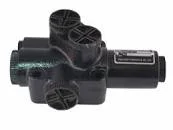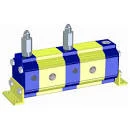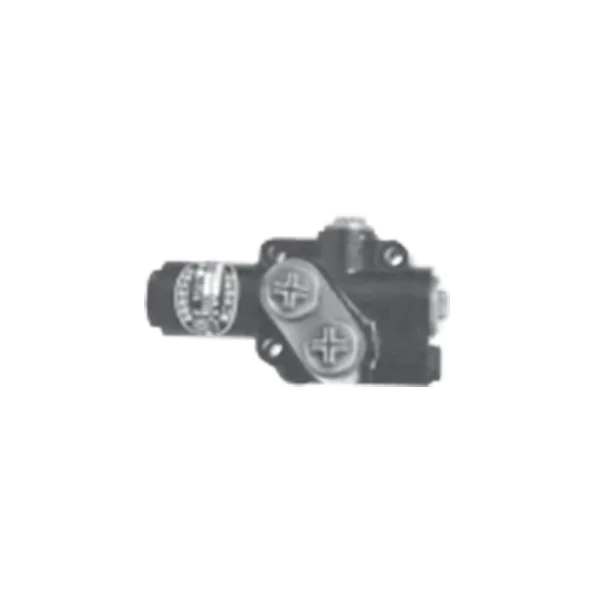Flow divider valves may not be the rockstars of hydraulic systems, but don't let their humble appearance fool you. These unassuming devices play a crucial role in ensuring smooth and efficient operation. Whether you're familiar with them or hearing about them for the first time, this blog post will shed light on how flow divider valves work and what makes up their key components. So, buckle up and get ready to dive into the fascinating world of flow control!
What are flow divider valves?
Flow divider valves, also known as flow dividers or flow splitters, are hydraulic devices that play a crucial role in ensuring consistent and balanced fluid distribution within a hydraulic system. As the name suggests, their main function is to divide the incoming flow of hydraulic fluid into two or more equal or proportionate streams.
These valves are typically used in applications where it is necessary to power multiple cylinders simultaneously with equal force and speed. By dividing the flow of hydraulic oil evenly among several branches, they ensure that each cylinder receives an equal amount of fluid and moves at the same rate.
Flow divider valves work based on a simple principle - they use internal mechanisms such as gears or spools to divide the incoming flow into separate outlets. The size and configuration of these internal components determine how the division is achieved, whether it's by splitting the flow equally between outlets or by proportionally dividing it based on specific ratios.
The key advantage of using a flow divider valve is its ability to provide synchronized movement across multiple actuators in a hydraulic system. This ensures uniformity in operations such as lifting heavy loads or moving different parts simultaneously. Additionally, these valves can be adjusted to suit specific requirements by altering pressure settings or selecting different ratios for proportional division.
However, like any other mechanical component, there are some limitations associated with using flow divider valves. For instance, they can introduce additional pressure drops due to their design features which need careful consideration during system design. It's important to choose an appropriate type and size of valve depending on your application requirements.
Flow divider valves are essential components that enable precise control over fluid distribution within a hydraulic system. Whether you're working with complex industrial machinery or handling delicate operations where synchronization matters most – understanding how these valves work and utilizing them effectively can make all the difference in achieving optimal performance!

How do they work?
Flow divider valves are hydraulic devices that play a crucial role in controlling the flow of fluid within a system. They work by dividing or proportioning the incoming flow into two or more separate outlets, ensuring equal distribution among them. This is achieved through a combination of mechanical and hydraulic principles.
At the heart of a flow divider valve is a spool assembly, which consists of multiple sections separated by seals. As fluid enters the valve, it encounters these sections and is directed towards different outlets based on their respective port connections. The size and configuration of these sections determine how much fluid flows to each outlet.
The key mechanism that enables this proportional division is the differential pressure across each section. As the pressure varies, certain sections open up while others close off, allowing for an even split in flow rate between outlets.
To ensure precise control, flow divider valves often incorporate additional components such as check valves and relief valves. These help maintain consistent pressure levels and protect against potential damage caused by excessive backflow or system overload.
Through its unique design and careful engineering, a flow divider valve allows for efficient distribution of fluid within hydraulic systems—a vital function in various industries such as agriculture, construction, manufacturing, and many others.
Key components of a flow divider valve
Flow divider valves are hydraulic devices that play a crucial role in ensuring equal distribution of flow between multiple circuits. Understanding the key components of these valves is essential to comprehend their functionality and make informed decisions about their usage.
1. Inlet Port: This is where the flow enters the valve from the pump or power source. It allows hydraulic fluid to pass into the valve for distribution.
2. Outlet Ports: These ports are responsible for dividing and directing the flow to different circuits or actuators. The number of outlet ports may vary depending on the specific design and application requirements.
3. Spool or Piston: The spool or piston within the valve controls how much fluid flows through each outlet port, regulating the division of flow among different circuits.
4. Check Valves: Incorporated within each outlet port, check valves prevent backflow from one circuit to another, ensuring proper isolation and independent operation.
5. Pressure Relief Valve: Some flow divider valves also feature pressure relief mechanisms that safeguard against excessive pressure buildup within individual circuits, protecting both equipment and operators.
Understanding these key components empowers engineers and technicians to select suitable flow divider valves based on system requirements, ultimately optimizing performance and efficiency in hydraulic systems without compromising safety or durability.

When to use a flow divider valve
When to use a flow divider valve? This is a question that arises when considering the application of this hydraulic component. Flow divider valves are primarily used in situations where you need to divide or distribute hydraulic fluid flow equally among multiple branches.
One key scenario where a flow divider valve comes in handy is when you have multiple cylinders or motors connected to a single power source, and you want each one to receive an equal amount of fluid flow. By using a flow divider valve, you can ensure that all branches receive the same amount of hydraulic fluid, resulting in synchronized movement or operation.
Another situation where these valves find their usefulness is in applications involving parallel circuits that require equal pressure and flow distribution. The flow divider valve helps maintain balance between the different branches by regulating the amount of fluid flowing through each one.
Additionally, if your system involves different loads on separate actuators and requires precise control over their speed or force, a flow divider valve can be employed to achieve this level of accuracy. It allows for individual adjustment and fine-tuning of each branch's performance according to specific requirements.
Moreover, any application that demands accurate positioning or synchronization across multiple actuators can benefit from using a flow diverter valve. These valves enable precise control and coordination between various components within the system.
Whenever there is a need for dividing hydraulic fluid evenly among multiple branches or achieving synchronized operation across parallel circuits with equal pressure distribution, it may be appropriate to consider incorporating a flow diverter valve into your system design.
Advantages and disadvantages of flow divider valves
Flow divider valves are essential components in hydraulic systems, providing precise control over the distribution of fluid between multiple circuits. Let's explore some of the advantages and disadvantages associated with these versatile devices.
One significant advantage of flow divider valves is their ability to ensure equal division of fluid flow among different branches or cylinders. This uniform distribution can be crucial in applications where synchronized movement is required, such as in construction equipment or agricultural machinery.
Another advantage is that flow divider valves allow for independent control of each circuit, enabling fine-tuning and optimization based on specific requirements. This flexibility enhances system efficiency and performance.
On the flip side, one potential disadvantage is that flow dividers introduce pressure losses due to internal resistance. These pressure drops may impact overall system output, particularly if high flows or pressures are involved. However, modern designs have minimized this issue by incorporating efficient internal passages.
Additionally, it's worth considering that improper selection or installation can lead to inadequate division accuracy or compromised reliability. It's important to carefully evaluate system specifications and consult with experts when implementing a flow divider valve solution.
While flow divider valves offer valuable benefits like equal fluid distribution and individual circuit control, they also come with considerations such as pressure losses and proper setup requirements. Careful assessment and expert guidance can help optimize their usage for improved hydraulic system performance.

Conclusion
Flow divider valves are essential components in hydraulic systems, allowing for precise control and distribution of fluid flow. They work by dividing the incoming flow into multiple outlets, ensuring that each outlet receives an equal or predetermined amount of fluid.
The key components of a flow divider valve include the inlet port, which allows fluid to enter the valve; the spool or piston mechanism that controls the division of flow; and the outlet ports through which the divided flow is sent to different parts of the system.
Understanding how flow divider valves work and their key components is vital for optimizing hydraulic system performance. By utilizing these valves strategically and considering their advantages and disadvantages, you can achieve efficient operation with reliable output across all branches within your system!Shanghai AJA Technology Co., Ltd. mainly sells products such as hydraulic motors, cycloidal hydraulic motors, hydraulic gear pumps, and supporting various valves, brakes, gearboxes, steering gear, steering column manufacturing and sales;Widely used in plastics, engineering, agriculture, construction, sanitation, petroleum, lifting, food and fishery CNC machine tools and other industries.If you need,welcome to contact us.15021387974@163.com
